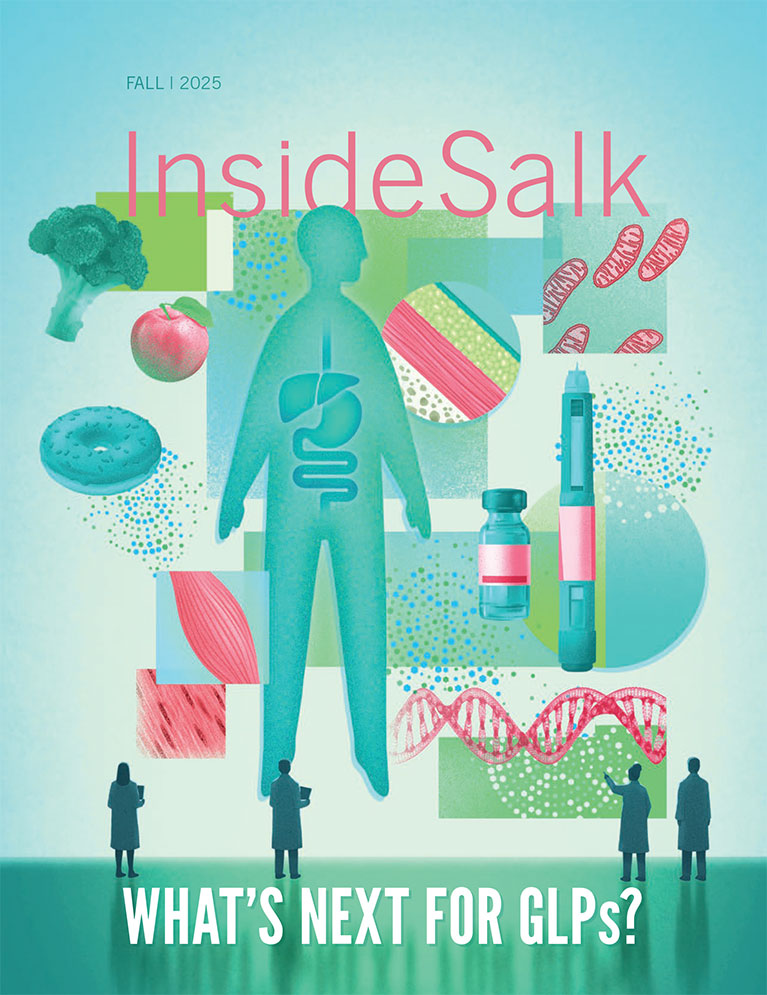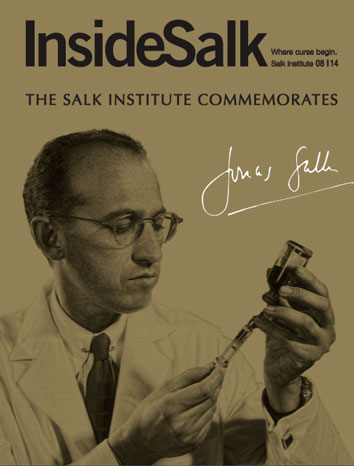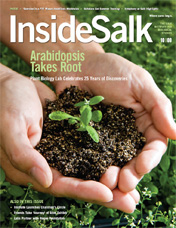Insights Julie Auger Shaping Salk’s science through shared resources
Julie Auger’s mother, a nurse, was at a conference in Illinois in the mid-1980s when she met medical researcher Jonas Salk—someone she had long admired for his development of the first safe and effective polio vaccine. She got his autograph and mailed it to Auger with a note saying, “Don’t ever stop trying to achieve your dreams.”
Auger took her mom’s advice, and today she is the executive director of Research Operations at the Salk Institute, which was founded by Jonas Salk in 1960. At the Institute, Auger manages the shared research core facilities. Cores are laboratories filled with technology and instrumentation that are typically too expensive for a single researcher to purchase. Instead, specialized equipment, such as high-powered microscopes, is purchased and located in dedicated, centralized laboratories. The cores enable scientists to perform cutting-edge experiments with the guidance of expert core personnel. This approach ensures innovative technologies are available to all and leads to more team-centered science, increasing collaboration and scientific discovery.
Inspiration
“My mother was extremely influential in my life. She always told me to not expect anyone else to take care of you. Women can achieve anything they want,” says Auger. “My mom taught me to be brave, and, importantly, that being a mother does not mean you have to give up on professional dreams.”
Early Life
Auger grew up in Strum, a small Wisconsin farming community of about 750 people. There were no scientists in Strum. “Winters in Wisconsin were freezing cold. I survived those winters reading anything I could get my hands on,” she says. But summers on the prairies were wonderful, and Auger enjoyed roaming the countryside in search of wild raspberries, frogs and birds.
When Auger was in eighth grade her mother’s best friend died of breast cancer. That experience solidified her commitment to scientific discovery, and she promised her mother that she would try to find a cure for cancer. Auger has played a strong role in many influential cancer research centers that have made great strides toward more effective cancer therapies.
Path to Salk
Auger’s interest in science was nurtured by her high school biology teacher and many mentors along her journey. She attended Saint Mary’s University of Minnesota and shortly after graduating got a job working at the Mayo Clinic Rochester in a flow cytometry lab, a technology that rapidly analyzes particles and cells to detect and quantify their chemical and physical properties.
Flow cytometry was a novel technique at the time, and the University of Illinois at Urbana-Champaign was creating a new flow cytometry core facility. Despite not having an advanced degree and being a young working mom, Auger readily accepted the challenge to develop the new technology center.
“For a long time, I felt like I was not worthy of the position. I was in a leadership role, guiding the science, but I didn’t have a PhD,” says Auger. “Then one day I was told by one of the scientists, ‘Julie, as long as you know more than anyone else here about flow cytometry, you are the expert.’ That was a pivotal moment as it gave me the confidence to better direct the conversation, accept even greater responsibility and continue to remain the expert.”
Auger directed that flow cytometry core for eight years before she was recruited to the University of Chicago to develop its cytometry core facility, as well as a few other shared research laboratories. At the request of renowned cancer researcher Janet Rowley, Auger also created an administrative structure to support all biomedical cores at the university. Seventeen years later, she was recruited by UC San Francisco, to do the same thing there—create central, coordinated administrative core facilities. She then built a similar structure at UC Davis.
She later consulted about the management structure of Salk’s core facilities. “I could see a few strategic changes that could benefit the Institute, and I thought it would be rewarding to lead those changes myself,” she says. She joined Salk in November 2021 as the executive director of Research Operations.
Day-to-day
Nearly every investigator at Salk uses one or more of the 11 cores that are managed by Auger. She must understand the science being conducted in the cores to properly support the scientists and essentially acts as the broker between the scientists and the Institute’s administration. For example, the Viral Vector Core might be developing a new cell delivery system using the rabies virus, while the Mass Spectrometry Core is focused on profiling protein complexes. She then communicates the scientists’ needs to Human Resources, Finance and other groups to acquire the necessary tools to make improvements and advance the facilities.
“My day-to-day includes a lot of learning about the needs of our scientists,” says Auger. “I also serve the needs of the core facilities staff and provide Salk’s executive leadership team with information about research infrastructure.”
Leisure time
Most of Auger’s leisure time is spent in her garden in Davis, California, where she lives on the weekends with her husband. She is an avid native plant gardener and affectionately refers to her home as the “Six B Ranch,” which stands for birds, butterflies, bats, bees and other bugs on the bank. A keen birder, Auger is also an amateur photographer who enjoys taking pictures of all the “Bs” that reside in her garden. Global travel is also high on her list of leisure priorities.
Long View/Future Projects
Shared research facilities are centers of expertise and technologies, and they are extremely important pillars of discovery science. Because core scientists focus on more broad research topics, they have the inherent ability to make a big impact on the scientific literature. “We need to continue to invest in, support and respect core scientists to make innovative discoveries,” says Auger. “Salk is a leader in investing in core scientists, and we can be a symbol in showing others how to continue to move from individual science to team science, which is the future.”
Are you up for the challenge?
Featured Stories
 What’s so special about Salk? Everything.An exceptional history, visionary design and trailblazing faculty make the Salk Institute unique among elite research institutions. And we’re just getting started. Today, Salk faculty are daily making discoveries that may one day turn the tide on Alzheimer’s, aging, cancers, climate change and more.
What’s so special about Salk? Everything.An exceptional history, visionary design and trailblazing faculty make the Salk Institute unique among elite research institutions. And we’re just getting started. Today, Salk faculty are daily making discoveries that may one day turn the tide on Alzheimer’s, aging, cancers, climate change and more. Margarita Behrens—Master of brain circuitsGrowing up in Chile, Research Professor Margarita Behrens was torn between becoming an architect and a scientist. She ultimately decided to pursue biochemistry. Now at Salk, Behrens studies how neurons develop in the brain. Her findings have implications for neurodevelopmental disorders such as schizophrenia and autism.
Margarita Behrens—Master of brain circuitsGrowing up in Chile, Research Professor Margarita Behrens was torn between becoming an architect and a scientist. She ultimately decided to pursue biochemistry. Now at Salk, Behrens studies how neurons develop in the brain. Her findings have implications for neurodevelopmental disorders such as schizophrenia and autism.
 Julie Auger—Shaping Salk’s science through shared resourcesJulie Auger’s mother was at a conference in the mid-1980s when she met Jonas Salk. She got his autograph and mailed it to Auger with a note saying, “Don’t ever stop trying to achieve your dreams.” Auger took her mom’s advice, and today she is the executive director of Research Operations at the Salk Institute.
Julie Auger—Shaping Salk’s science through shared resourcesJulie Auger’s mother was at a conference in the mid-1980s when she met Jonas Salk. She got his autograph and mailed it to Auger with a note saying, “Don’t ever stop trying to achieve your dreams.” Auger took her mom’s advice, and today she is the executive director of Research Operations at the Salk Institute. Gaurav Mendiratta— Using math to solve cancerJumping from theoretical physics to cancer research with no prior training in biological sciences wasn’t an easy transition for Gaurav Mendiratta. Couple this with a move across the world and the birth of his first child shortly after starting his postdoctoral training in a newly opened laboratory—Mendiratta had his work cut out for him.
Gaurav Mendiratta— Using math to solve cancerJumping from theoretical physics to cancer research with no prior training in biological sciences wasn’t an easy transition for Gaurav Mendiratta. Couple this with a move across the world and the birth of his first child shortly after starting his postdoctoral training in a newly opened laboratory—Mendiratta had his work cut out for him. A trailblazer’s lasting legacy: Ursula Bellugi bridged humanity and scienceDespite being a world-renowned, award-winning scientific pioneer, Distinguished Professor Emerita Ursula Bellugi didn’t like to say she was smart. Instead, she credited her tremendous success to her insatiable curiosity and her willingness to ask the right questions. This past spring, the world lost a true trailblazer.
A trailblazer’s lasting legacy: Ursula Bellugi bridged humanity and scienceDespite being a world-renowned, award-winning scientific pioneer, Distinguished Professor Emerita Ursula Bellugi didn’t like to say she was smart. Instead, she credited her tremendous success to her insatiable curiosity and her willingness to ask the right questions. This past spring, the world lost a true trailblazer.




















































